Unit 4 Amazing Science Topic 1 Section B(教学设计)(表格式)-2024-2025学年(仁爱科普版)英语九年级上册
文档属性
| 名称 | Unit 4 Amazing Science Topic 1 Section B(教学设计)(表格式)-2024-2025学年(仁爱科普版)英语九年级上册 | 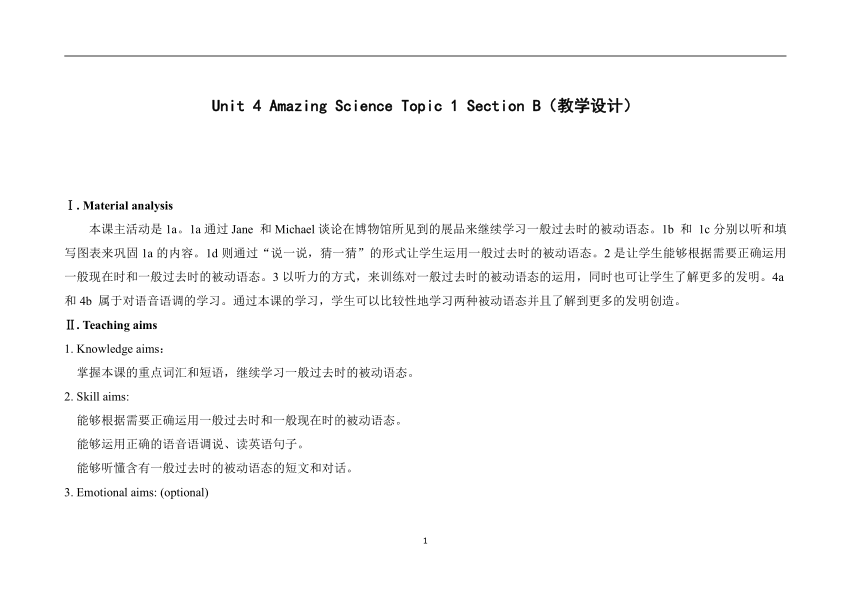 | |
| 格式 | doc | ||
| 文件大小 | 87.3KB | ||
| 资源类型 | 教案 | ||
| 版本资源 | 仁爱科普版 | ||
| 科目 | 英语 | ||
| 更新时间 | 2025-01-26 14:02:39 | ||
图片预览

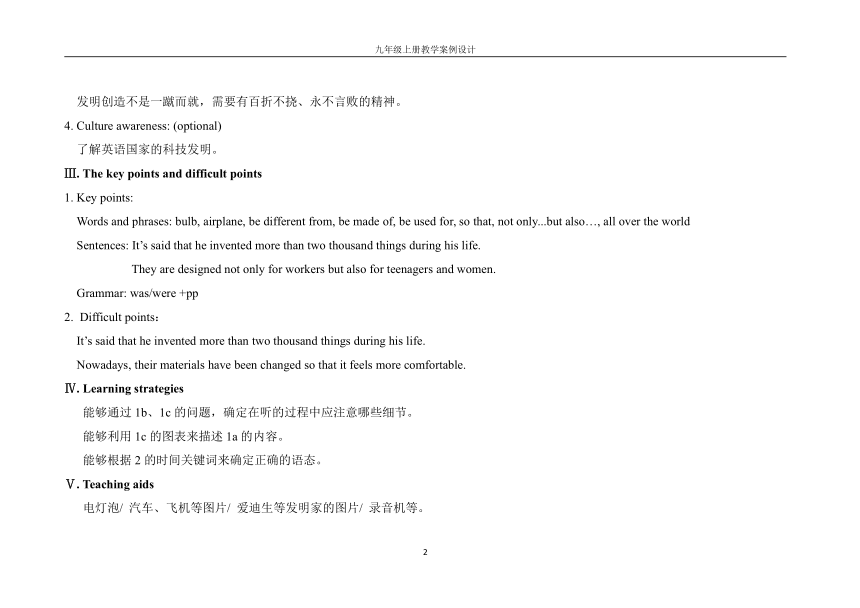
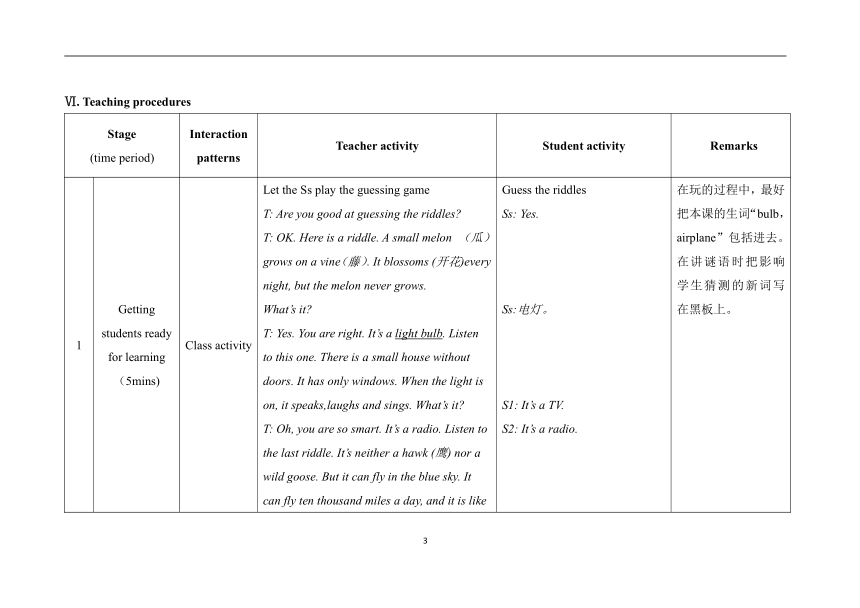
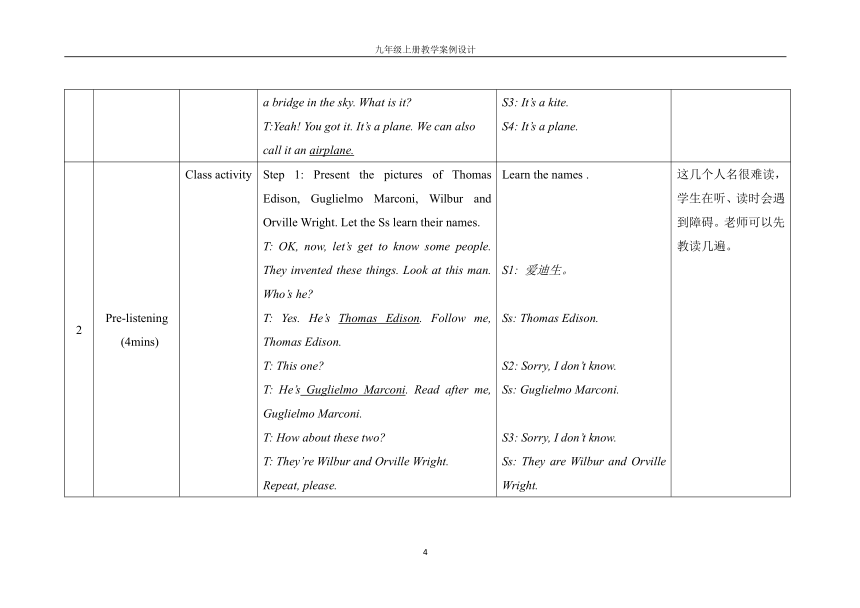
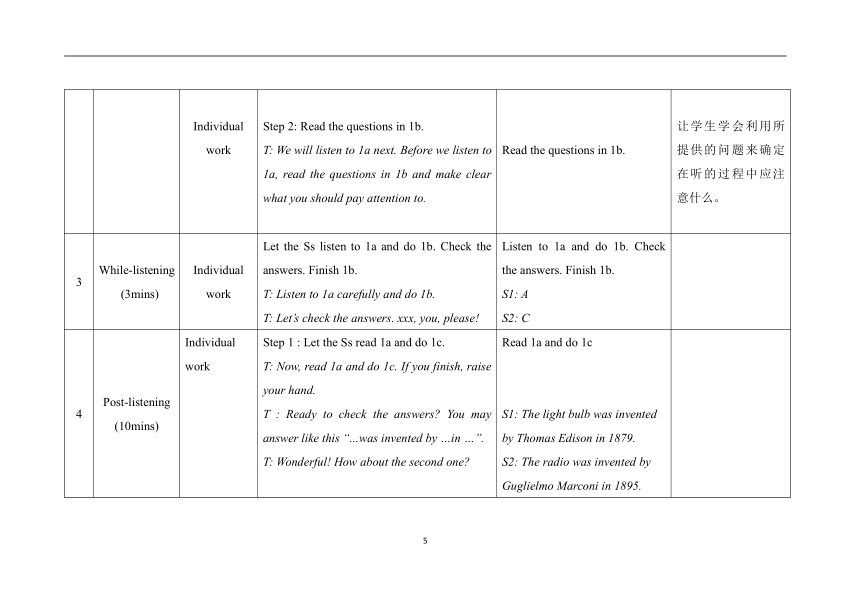
文档简介
九年级上册教学案例设计
Unit 4 Amazing Science Topic 1 Section B(教学设计)
Ⅰ. Material analysis
本课主活动是1a。1a通过Jane 和Michael谈论在博物馆所见到的展品来继续学习一般过去时的被动语态。1b 和 1c分别以听和填写图表来巩固1a的内容。1d则通过“说一说,猜一猜”的形式让学生运用一般过去时的被动语态。2是让学生能够根据需要正确运用一般现在时和一般过去时的被动语态。3以听力的方式,来训练对一般过去时的被动语态的运用,同时也可让学生了解更多的发明。4a和4b 属于对语音语调的学习。通过本课的学习,学生可以比较性地学习两种被动语态并且了解到更多的发明创造。
Ⅱ. Teaching aims
1. Knowledge aims:
掌握本课的重点词汇和短语,继续学习一般过去时的被动语态。
2. Skill aims:
能够根据需要正确运用一般过去时和一般现在时的被动语态。
能够运用正确的语音语调说、读英语句子。
能够听懂含有一般过去时的被动语态的短文和对话。
3. Emotional aims: (optional)
发明创造不是一蹴而就,需要有百折不挠、永不言败的精神。
4. Culture awareness: (optional)
了解英语国家的科技发明。
Ⅲ. The key points and difficult points
1. Key points:
Words and phrases: bulb, airplane, be different from, be made of, be used for, so that, not only...but also…, all over the world
Sentences: It’s said that he invented more than two thousand things during his life.
They are designed not only for workers but also for teenagers and women.
Grammar: was/were +pp
Difficult points:
It’s said that he invented more than two thousand things during his life.
Nowadays, their materials have been changed so that it feels more comfortable.
Ⅳ. Learning strategies
能够通过1b、1c的问题,确定在听的过程中应注意哪些细节。
能够利用1c的图表来描述1a的内容。
能够根据2的时间关键词来确定正确的语态。
Ⅴ. Teaching aids
电灯泡/ 汽车、飞机等图片/ 爱迪生等发明家的图片/ 录音机等。
Ⅵ. Teaching procedures
Stage(time period) Interactionpatterns Teacher activity Student activity Remarks
1 Getting students ready for learning(5mins) Class activity Let the Ss play the guessing gameT: Are you good at guessing the riddles T: OK. Here is a riddle. A small melon (瓜)grows on a vine(藤). It blossoms (开花)every night, but the melon never grows.What’s it T: Yes. You are right. It’s a light bulb. Listen to this one. There is a small house without doors. It has only windows. When the light is on, it speaks,laughs and sings. What’s it T: Oh, you are so smart. It’s a radio. Listen to the last riddle. It’s neither a hawk (鹰) nor a wild goose. But it can fly in the blue sky. It can fly ten thousand miles a day, and it is like a bridge in the sky. What is it T:Yeah! You got it. It’s a plane. We can also call it an airplane. Guess the riddles Ss: Yes.Ss:电灯。S1: It’s a TV.S2: It’s a radio.S3: It’s a kite.S4: It’s a plane. 在玩的过程中,最好把本课的生词“bulb,airplane”包括进去。在讲谜语时把影响学生猜测的新词写在黑板上。
2 Pre-listening (4mins) Class activityIndividual work Step 1: Present the pictures of Thomas Edison, Guglielmo Marconi, Wilbur and Orville Wright. Let the Ss learn their names.T: OK, now, let’s get to know some people. They invented these things. Look at this man. Who’s he T: Yes. He’s Thomas Edison. Follow me, Thomas Edison.T: This one T: He’s Guglielmo Marconi. Read after me, Guglielmo Marconi.T: How about these two T: They’re Wilbur and Orville Wright.Repeat, please.Step 2: Read the questions in 1b.T: We will listen to 1a next. Before we listen to 1a, read the questions in 1b and make clear what you should pay attention to. Learn the names .S1: 爱迪生。Ss: Thomas Edison.S2: Sorry, I don’t know.Ss: Guglielmo Marconi.S3: Sorry, I don’t know.Ss: They are Wilbur and Orville Wright.Read the questions in 1b. 这几个人名很难读,学生在听、读时会遇到障碍。老师可以先教读几遍。让学生学会利用所提供的问题来确定在听的过程中应注意什么。
3 While-listening (3mins) Individual work Let the Ss listen to 1a and do 1b. Check the answers. Finish 1b.T: Listen to 1a carefully and do 1b.T: Let’s check the answers. xxx, you, please! Listen to 1a and do 1b. Check the answers. Finish 1b.S1: AS2: C
4 Post-listening(10mins) Individual workGroup work Class activity Step 1 : Let the Ss read 1a and do 1c.T: Now, read 1a and do 1c. If you finish, raise your hand.T : Ready to check the answers You may answer like this “...was invented by …in …”.T: Wonderful! How about the second one T: You did a great job. The last one T: I’m very proud of you!Step 2: Let the Ss do the guessing game and finish 1d. T: Now work in groups to make riddles by yourself. You will describe the inventions in 1c and let other groups guess what you are describing. You can follow the example in 1d. When you finish, hands up!T: Time is up! Which group wants to be No. 1 T: You all performed very well!Step 3: Let the Ss read 1a again and find out the difficult and key points.T: Read 1a again and find out the difficult and key points.T: Do you have any questions T: Good question! It’s a very useful expression. It means someone said something, but it may be not true. We have another expression “It’s reported that…”.T: What else T: How about the key points Read 1a and do 1cS1: The light bulb was invented by Thomas Edison in 1879.S2: The radio was invented by Guglielmo Marconi in 1895.S3: The airplane was invented by Wilbur and Orville Wright in 1903. Do the guessing game and finish 1d.S1(Group2): It’s widely used by people everywhere. It was invented by an American inventor. It’s said that he failed 999 times before he succeeded in this great invention.S2(Group4): It’s light bulb. S3(Group 1):…S4(Group 3): It’s … Read 1a again and find out the difficult and key points.S1: What does the sentence “It’s said that ….” in Row 6 mean S2:It’s said that …S3:It’s reported that…S4:be different from…
5 FinishingTask 2(5mins) Individual workClass activity Step1: Let the Ss do 2, check the answers and finish 2.T: Now, work alone. Finish the blanks in 2. Pay attention to the time when filling in the blanks. When you finish, raise your hand.T: xxx, may I begin with you T: Perfect! Step2: Write down on the Bb the sentence “Nowadays, their materials have been changed so that it feels more comfortable”. Let the Ss understand the perfect passive.T: Look at this sentence. Who can tell me what it means T: S2 is right. “Have/has been+pp” is perfect passive voice. Do 2, check the answers andfinish 2.S1: Sure. weren’t called S2: were madeS3: was, usedS4: are, created S5: are, designedKnow about the perfect passive.S1:现在他们的制作材料已经变了,因此摸起来更舒适。S2:现在他们的制作材料已经被改变了,以至于摸起来更舒适。 要学生养成观察关键词的习惯。如:nowadays .完成时的被动语态,不要求精讲,只要学生能理解这样的句子即可。老师稍微点一下就行了。
6 FinishingTask 3(5mins) Individual work Let the Ss listen to 3, check the answers and finish 3.T: Look at the pictures in 3. Listen to the tape and match them.T: May I check the answers now You may answer like this “The …was invented by …in …”. Any volunteers T: Well done. Listen to 3, check the answers and finish 3. S1:The car was invented by Karl Benz in 1926.S2: The phone was invented by Alexander Graham Bell in 1876.S3: The TV was invented by John Baird in 1885.
7 FinishingTask 4a(3mins) Individual work Let the Ss read the words, and then listen to the tape and check the vowels.T: Read the words first and pay attention to the vowels.T: Now, listen to the tape. Follow it and check the vowels. Read the words, and then listen to the tape and check the vowels.
8 FinishingTask 4b(5mins) Individual workPair work Step1: Listen and read the sentences in 4b, and find out the rules of stress and intonation.T: Listen and read the sentences in 4b and find out the rules of stress and intonation.T: What have you found, xxx T: Good job. Step2: Let the Ss make up similar conversations using the words in 4a. T: Now, pair work. Use the words in 4a to make up similar conversations. If you finish, raise your hand. T: Which pair wants to have a try Listen and read the sentences in 4b and find out the rules of stress and intonation.S1:特殊疑问句句尾读降调。S2:陈述句句尾读降调。S3:一般疑问句句尾读升调,回答读降调。S4:句首的特殊疑问词要重读,实义动词要重读。Use the words in 4a to make up similar conversations.S1:When was the laptop developed S2: It was developed in 1985.S1: Was the laptop developed in the U.S.A S2: No.S1: Where was it developed S2: It was developed in Japan.
9 Summarizing and assigninghomework (5mins) Class activity Step 1: Let the Ss sum up the key points of this section.T: Now, it’s time to sum up the key points. What are they Step 2: HMKT: We have learned some inventions. I would like you to think about more inventions, and try to find out their inventors. Sum up the key points of this section. S1: It’s said that…, It’s reported that…S2: be different from, be made of…S3: have / has been + pp S4: so that, not only … but also…S5:…
Ⅶ. Blackboard design
When was it invented Section B
Words and phrases:bulbplane=airplane Grammar:was/were +pphave/has been+pp
Sentences:It’s said that he invented more than two thousand things during his life.Nowadays, their materials have been changed so that it feels more comfortable.They are designed not only for workers but also for teenagers and women.
12
1
Unit 4 Amazing Science Topic 1 Section B(教学设计)
Ⅰ. Material analysis
本课主活动是1a。1a通过Jane 和Michael谈论在博物馆所见到的展品来继续学习一般过去时的被动语态。1b 和 1c分别以听和填写图表来巩固1a的内容。1d则通过“说一说,猜一猜”的形式让学生运用一般过去时的被动语态。2是让学生能够根据需要正确运用一般现在时和一般过去时的被动语态。3以听力的方式,来训练对一般过去时的被动语态的运用,同时也可让学生了解更多的发明。4a和4b 属于对语音语调的学习。通过本课的学习,学生可以比较性地学习两种被动语态并且了解到更多的发明创造。
Ⅱ. Teaching aims
1. Knowledge aims:
掌握本课的重点词汇和短语,继续学习一般过去时的被动语态。
2. Skill aims:
能够根据需要正确运用一般过去时和一般现在时的被动语态。
能够运用正确的语音语调说、读英语句子。
能够听懂含有一般过去时的被动语态的短文和对话。
3. Emotional aims: (optional)
发明创造不是一蹴而就,需要有百折不挠、永不言败的精神。
4. Culture awareness: (optional)
了解英语国家的科技发明。
Ⅲ. The key points and difficult points
1. Key points:
Words and phrases: bulb, airplane, be different from, be made of, be used for, so that, not only...but also…, all over the world
Sentences: It’s said that he invented more than two thousand things during his life.
They are designed not only for workers but also for teenagers and women.
Grammar: was/were +pp
Difficult points:
It’s said that he invented more than two thousand things during his life.
Nowadays, their materials have been changed so that it feels more comfortable.
Ⅳ. Learning strategies
能够通过1b、1c的问题,确定在听的过程中应注意哪些细节。
能够利用1c的图表来描述1a的内容。
能够根据2的时间关键词来确定正确的语态。
Ⅴ. Teaching aids
电灯泡/ 汽车、飞机等图片/ 爱迪生等发明家的图片/ 录音机等。
Ⅵ. Teaching procedures
Stage(time period) Interactionpatterns Teacher activity Student activity Remarks
1 Getting students ready for learning(5mins) Class activity Let the Ss play the guessing gameT: Are you good at guessing the riddles T: OK. Here is a riddle. A small melon (瓜)grows on a vine(藤). It blossoms (开花)every night, but the melon never grows.What’s it T: Yes. You are right. It’s a light bulb. Listen to this one. There is a small house without doors. It has only windows. When the light is on, it speaks,laughs and sings. What’s it T: Oh, you are so smart. It’s a radio. Listen to the last riddle. It’s neither a hawk (鹰) nor a wild goose. But it can fly in the blue sky. It can fly ten thousand miles a day, and it is like a bridge in the sky. What is it T:Yeah! You got it. It’s a plane. We can also call it an airplane. Guess the riddles Ss: Yes.Ss:电灯。S1: It’s a TV.S2: It’s a radio.S3: It’s a kite.S4: It’s a plane. 在玩的过程中,最好把本课的生词“bulb,airplane”包括进去。在讲谜语时把影响学生猜测的新词写在黑板上。
2 Pre-listening (4mins) Class activityIndividual work Step 1: Present the pictures of Thomas Edison, Guglielmo Marconi, Wilbur and Orville Wright. Let the Ss learn their names.T: OK, now, let’s get to know some people. They invented these things. Look at this man. Who’s he T: Yes. He’s Thomas Edison. Follow me, Thomas Edison.T: This one T: He’s Guglielmo Marconi. Read after me, Guglielmo Marconi.T: How about these two T: They’re Wilbur and Orville Wright.Repeat, please.Step 2: Read the questions in 1b.T: We will listen to 1a next. Before we listen to 1a, read the questions in 1b and make clear what you should pay attention to. Learn the names .S1: 爱迪生。Ss: Thomas Edison.S2: Sorry, I don’t know.Ss: Guglielmo Marconi.S3: Sorry, I don’t know.Ss: They are Wilbur and Orville Wright.Read the questions in 1b. 这几个人名很难读,学生在听、读时会遇到障碍。老师可以先教读几遍。让学生学会利用所提供的问题来确定在听的过程中应注意什么。
3 While-listening (3mins) Individual work Let the Ss listen to 1a and do 1b. Check the answers. Finish 1b.T: Listen to 1a carefully and do 1b.T: Let’s check the answers. xxx, you, please! Listen to 1a and do 1b. Check the answers. Finish 1b.S1: AS2: C
4 Post-listening(10mins) Individual workGroup work Class activity Step 1 : Let the Ss read 1a and do 1c.T: Now, read 1a and do 1c. If you finish, raise your hand.T : Ready to check the answers You may answer like this “...was invented by …in …”.T: Wonderful! How about the second one T: You did a great job. The last one T: I’m very proud of you!Step 2: Let the Ss do the guessing game and finish 1d. T: Now work in groups to make riddles by yourself. You will describe the inventions in 1c and let other groups guess what you are describing. You can follow the example in 1d. When you finish, hands up!T: Time is up! Which group wants to be No. 1 T: You all performed very well!Step 3: Let the Ss read 1a again and find out the difficult and key points.T: Read 1a again and find out the difficult and key points.T: Do you have any questions T: Good question! It’s a very useful expression. It means someone said something, but it may be not true. We have another expression “It’s reported that…”.T: What else T: How about the key points Read 1a and do 1cS1: The light bulb was invented by Thomas Edison in 1879.S2: The radio was invented by Guglielmo Marconi in 1895.S3: The airplane was invented by Wilbur and Orville Wright in 1903. Do the guessing game and finish 1d.S1(Group2): It’s widely used by people everywhere. It was invented by an American inventor. It’s said that he failed 999 times before he succeeded in this great invention.S2(Group4): It’s light bulb. S3(Group 1):…S4(Group 3): It’s … Read 1a again and find out the difficult and key points.S1: What does the sentence “It’s said that ….” in Row 6 mean S2:It’s said that …S3:It’s reported that…S4:be different from…
5 FinishingTask 2(5mins) Individual workClass activity Step1: Let the Ss do 2, check the answers and finish 2.T: Now, work alone. Finish the blanks in 2. Pay attention to the time when filling in the blanks. When you finish, raise your hand.T: xxx, may I begin with you T: Perfect! Step2: Write down on the Bb the sentence “Nowadays, their materials have been changed so that it feels more comfortable”. Let the Ss understand the perfect passive.T: Look at this sentence. Who can tell me what it means T: S2 is right. “Have/has been+pp” is perfect passive voice. Do 2, check the answers andfinish 2.S1: Sure. weren’t called S2: were madeS3: was, usedS4: are, created S5: are, designedKnow about the perfect passive.S1:现在他们的制作材料已经变了,因此摸起来更舒适。S2:现在他们的制作材料已经被改变了,以至于摸起来更舒适。 要学生养成观察关键词的习惯。如:nowadays .完成时的被动语态,不要求精讲,只要学生能理解这样的句子即可。老师稍微点一下就行了。
6 FinishingTask 3(5mins) Individual work Let the Ss listen to 3, check the answers and finish 3.T: Look at the pictures in 3. Listen to the tape and match them.T: May I check the answers now You may answer like this “The …was invented by …in …”. Any volunteers T: Well done. Listen to 3, check the answers and finish 3. S1:The car was invented by Karl Benz in 1926.S2: The phone was invented by Alexander Graham Bell in 1876.S3: The TV was invented by John Baird in 1885.
7 FinishingTask 4a(3mins) Individual work Let the Ss read the words, and then listen to the tape and check the vowels.T: Read the words first and pay attention to the vowels.T: Now, listen to the tape. Follow it and check the vowels. Read the words, and then listen to the tape and check the vowels.
8 FinishingTask 4b(5mins) Individual workPair work Step1: Listen and read the sentences in 4b, and find out the rules of stress and intonation.T: Listen and read the sentences in 4b and find out the rules of stress and intonation.T: What have you found, xxx T: Good job. Step2: Let the Ss make up similar conversations using the words in 4a. T: Now, pair work. Use the words in 4a to make up similar conversations. If you finish, raise your hand. T: Which pair wants to have a try Listen and read the sentences in 4b and find out the rules of stress and intonation.S1:特殊疑问句句尾读降调。S2:陈述句句尾读降调。S3:一般疑问句句尾读升调,回答读降调。S4:句首的特殊疑问词要重读,实义动词要重读。Use the words in 4a to make up similar conversations.S1:When was the laptop developed S2: It was developed in 1985.S1: Was the laptop developed in the U.S.A S2: No.S1: Where was it developed S2: It was developed in Japan.
9 Summarizing and assigninghomework (5mins) Class activity Step 1: Let the Ss sum up the key points of this section.T: Now, it’s time to sum up the key points. What are they Step 2: HMKT: We have learned some inventions. I would like you to think about more inventions, and try to find out their inventors. Sum up the key points of this section. S1: It’s said that…, It’s reported that…S2: be different from, be made of…S3: have / has been + pp S4: so that, not only … but also…S5:…
Ⅶ. Blackboard design
When was it invented Section B
Words and phrases:bulbplane=airplane Grammar:was/were +pphave/has been+pp
Sentences:It’s said that he invented more than two thousand things during his life.Nowadays, their materials have been changed so that it feels more comfortable.They are designed not only for workers but also for teenagers and women.
12
1
同课章节目录
- Unit 1 The Changing World
- Topic 1 Our country has developed rapidly.
- Topic 2 The population in developing countries is
- Topic 3 The world has changed for the better.
- Unit 2 Saving the earth.
- Topic 1 Pollution has causes too many problems.
- Topic 2 All these problems are very serious.
- Topic 3 What can we do to protect the environment
- Unit 3 English around the World
- Topic 1 English is widely spoken around the world.
- Topic 2 Some things usually have different meaning
- Topic 3 Could you give us some advice on how to l
- Unit 4 Amazing Science
- Topic 1 When was it invented?
- Topic 2 I'm excited about the things that will be
- Topic 3 China is the third nation that sent a pers
